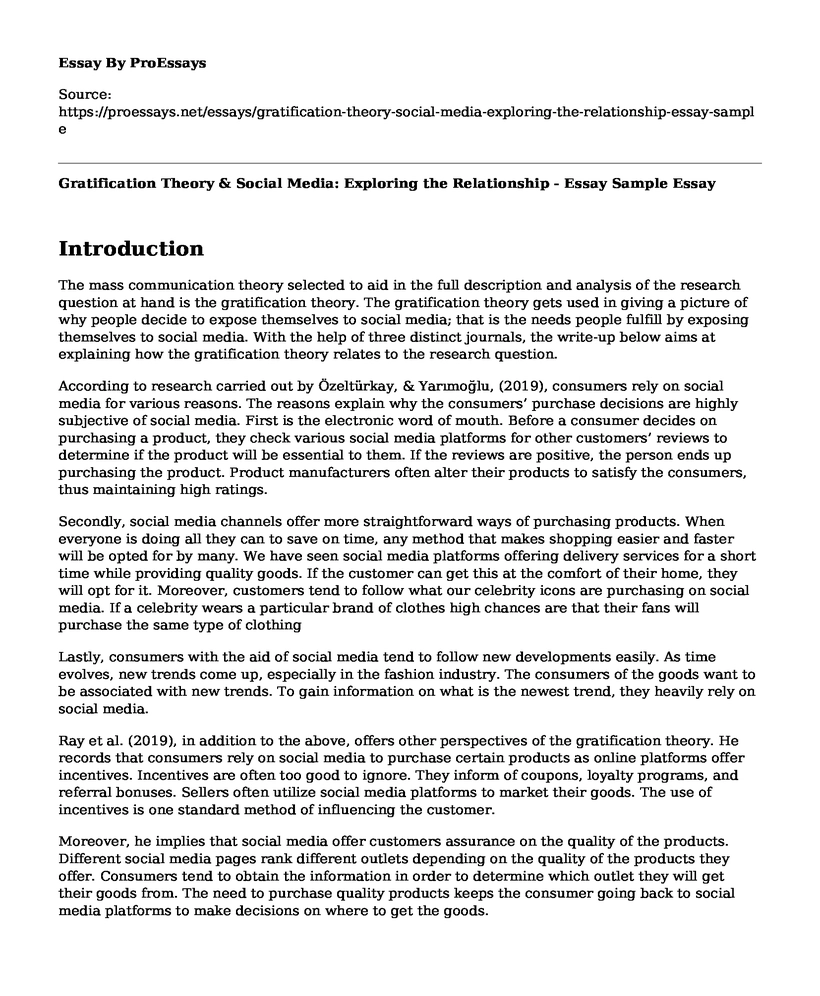Introduction
The mass communication theory selected to aid in the full description and analysis of the research question at hand is the gratification theory. The gratification theory gets used in giving a picture of why people decide to expose themselves to social media; that is the needs people fulfill by exposing themselves to social media. With the help of three distinct journals, the write-up below aims at explaining how the gratification theory relates to the research question.
According to research carried out by Özeltürkay, & Yarimoglu, (2019), consumers rely on social media for various reasons. The reasons explain why the consumers’ purchase decisions are highly subjective of social media. First is the electronic word of mouth. Before a consumer decides on purchasing a product, they check various social media platforms for other customers’ reviews to determine if the product will be essential to them. If the reviews are positive, the person ends up purchasing the product. Product manufacturers often alter their products to satisfy the consumers, thus maintaining high ratings.
Secondly, social media channels offer more straightforward ways of purchasing products. When everyone is doing all they can to save on time, any method that makes shopping easier and faster will be opted for by many. We have seen social media platforms offering delivery services for a short time while providing quality goods. If the customer can get this at the comfort of their home, they will opt for it. Moreover, customers tend to follow what our celebrity icons are purchasing on social media. If a celebrity wears a particular brand of clothes high chances are that their fans will purchase the same type of clothing
Lastly, consumers with the aid of social media tend to follow new developments easily. As time evolves, new trends come up, especially in the fashion industry. The consumers of the goods want to be associated with new trends. To gain information on what is the newest trend, they heavily rely on social media.
Ray et al. (2019), in addition to the above, offers other perspectives of the gratification theory. He records that consumers rely on social media to purchase certain products as online platforms offer incentives. Incentives are often too good to ignore. They inform of coupons, loyalty programs, and referral bonuses. Sellers often utilize social media platforms to market their goods. The use of incentives is one standard method of influencing the customer.
Moreover, he implies that social media offer customers assurance on the quality of the products. Different social media pages rank different outlets depending on the quality of the products they offer. Consumers tend to obtain the information in order to determine which outlet they will get their goods from. The need to purchase quality products keeps the consumer going back to social media platforms to make decisions on where to get the goods.
Huang, Bao, & Li, (2017), summarizes the needs that cause a consumer to use social media to purchase a good into three. It helps them determine how effective it is in accomplishing its intended use, how it gets presented, and its flexibility. Customers make a habit of purchasing goods that are well presented. Customers also purchase goods that can perform many roles while saving on the cost and space the product will consume. The effectiveness of a product plays a huge role in influencing a customer's purchase. The above three measures will keep a customer scrolling through social media to decide what good they will purchase.
Conclusion
In conclusion, the gratification theory gives a clear picture of how the reliance on social media for news and information affects the consumers' perspectives on the world. Consumers get dependant on social media in order to acquire quality goods in good time. Social media platforms offer information on what others think about the product, the best stores, and various product changes. The information is then utilized by consumers to make purchase decisions.
References
Ray, A., Dhir, A., Bala, P. K., & Kaur, P. (2019). Why do people use food delivery apps (FDA)? A uses and gratification theory perspective. Journal of Retailing and Consumer Services, 51, 221-230.
Huang, T., Bao, Z., & Li, Y. (2017). Why do players purchase in mobile social network games? An examination of customer engagement and of uses and gratifications theory. Program.
Özeltürkay, E. Y., & Yarimoglu, E. (2019). How and why consumers use social media: a qualitative study based on user-generated media and uses & gratifications theory.
Cite this page
Gratification Theory & Social Media: Exploring the Relationship - Essay Sample. (2023, Aug 27). Retrieved from https://proessays.net/essays/gratification-theory-social-media-exploring-the-relationship-essay-sample
If you are the original author of this essay and no longer wish to have it published on the ProEssays website, please click below to request its removal:
- Greek and Egyptian Fashion Essay
- Chris Brown Biography
- Effects of Social Media on Teenagers Essay
- Film Analysis Essay on The Life and Debt in Jamaica
- The African Americans Many River to Cross Episode 2 Essay Example
- Essay Sample on Closing the Digital Divide: 3 Essential Measures
- Essay Example on Catherine de Medici's Role in Ballet Evolution in Feudal Society







